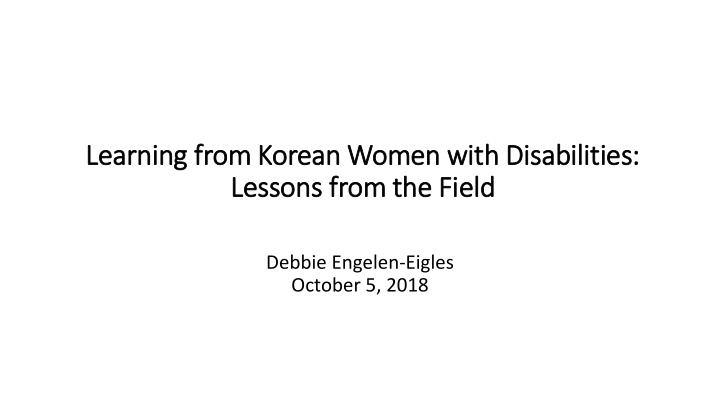



Learning fr from Korean Women wit ith Dis isabilities: Lessons fr from the Fie ield Debbie Engelen-Eigles October 5, 2018
Research Questions 1. What barriers do women with disabilities in Korea face to accessing quality, effective health care? 2. What strategies do the women use to address these challenges? 3. What would they like doctors and other health care workers to know; what changes would they like to see to improve their health care experience?
Research Procedure • Qualitative interviews using semi-structured interview guide • Snowball sampling procedure; participants recruited through disabled women’s advocacy organizations, Independent Living Centers, professional contacts • Goal of maximum variation as a form of purposive sampling to achieve theoretical saturation (Palys, 2008) • Worked with associate as interpreter and “cultural bridge”
Interviewee Demographics: Relationship Status 25 20 20 15 13 10 5 2 1 0 Single Married Divorced Widowed
Interviewee Demographics: Parenting Status 25 21 20 15 11 10 4 5 0 Not a parent Had child(ren) prior to Had child(ren) after acquiring disability acquiring disability
Interviewee Demographics: Education 10 9 9 8 8 7 7 6 6 5 5 4 3 2 1 1 0 No formal Middle High school Some college 4-year Postgraduate education school degree
Interviewee Demographics: Current Primary Activity 20 18 18 16 14 12 10 7 7 8 6 6 4 2 2 0 Note: Total adds to more than 36 due to interviewees’ reporting multiple activities.
Interviewee Demographics: Characteristics of Interviewee’s Disability 35 35 32 29 30 30 25 25 20 20 15 15 10 10 7 5 3 5 1 0 0 Congenital Acquired Visible Hidden Both
Interviewee Demographics: Type of Disability Cerebral palsy 10 Post-polio syndrome 8 Quadriplegia 3 Paraplegia 1 Osteogenesis imperfecta 2 Hearing impairment 3 Visual impairment 4 Kidney disease 2 Cognitive impairment 1 Muscular dystrophy 2 Chronic pain 1 Other mobility impairment 1 0 2 4 6 8 10 12 Note: Total adds to more than 36 due to interviewees’ presenting multiple disabilities.
(Photos from Google images)
Council for International Exchange of Scholars (CIES) U.S. SCHOLAR Programs offer U.S. faculty, administrators and professionals grants to lecture, conduct research in a wide variety of academic and professional fields, or to participate in seminars. NON-U.S. SCHOLAR Programs support the research and teaching of scholars visiting colleges and universities in the United States. These programs offer joint collaborative opportunities with U.S. Scholars. Opportunities for U.S. INSTITUTIONS allow campuses to host Fulbright Visiting Scholars and professionals from abroad to lecture at U.S. colleges and universities. www.cies.org
Other Fulbright Programs Fulbright U.S. Student Program : For recent graduates, postgraduate candidates up through dissertation level and developing professionals and artists to study and research abroad Fulbright Teacher Exchange Programs: Principally for primary- and secondary- level educators Fulbright-Hays Awards: For faculty research, group projects and seminars abroad in certain social sciences and humanities fields Learn more about IIE programs: www.iie.org
Stay Engaged! • Sign up for MyFulbright to receive tailored messages regarding the Fulbright Scholar Program • Invite a Visiting Scholar to your campus through the Outreach Lecturing Fund • Register for an upcoming Webinar Questions? Email outreach@iie.org
Recommend
More recommend